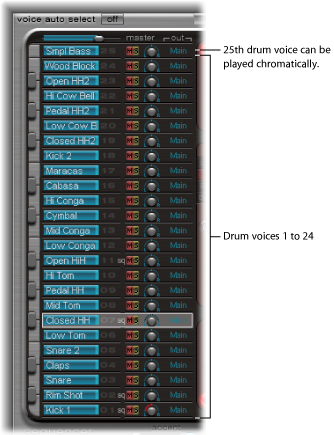Getting to Know the Structure of Ultrabeat
Most software synthesizers offer one synthesizer per plug-in instance. Ultrabeat, however, places 25 independent synthesizers at your disposal. These synthesizers—known asdrum voices in Ultrabeat—are optimized for the generation of drum and percussion sounds.
The distribution of drum voices across the MIDI keyboard is simple—a single drum voice is assigned to the first 24 MIDI keys, starting from the bottom. The 25th drum voice is assigned to the keys above—from the 25th key—allowing this sound to be played chromatically.

You can compare Ultrabeat with a drum machine that features 24 drum pads, plus a built-in multioctave keyboard, which can be used for polyphonic accompaniments, or bass or melody lines.
Ultrabeat’s 24 drum pads are assigned to the bottom 24 keys of a standard MIDI keyboard (spanning MIDI notes C1 to B2). This is compatible with the widely adopted GM (General MIDI) MIDI Drum note mapping standard. The lowest note in the range for the 25th synthesizer begins at C3. All notes above—and C3 itself—can be played chromatically.
Note: If your MIDI keyboard is limited to two octaves or does not support transposition, you can use the Transpose parameter of your host application to shift incoming MIDI notes up or down one or more octaves.
Important: For clarity, and to maintain the drum machine analogy, this guide refers to the independent synthesizers as drum sounds that, combined, form a drum kit.